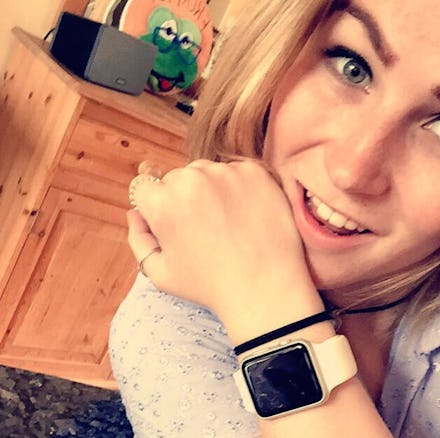A Deafblind Woman Found a Hidden Feature in Her Apple Watch That Changed Her Life

Using one overlooked feature on her Apple Watch, a blind and deaf woman learned to navigate any city.
This is Molly Watt, a woman living with a genetic disorder called Usher syndrome that affects her sight and hearing. She began experimenting with the functionality of her Apple Watch in April.
There's been plenty of negative commentary popping up online about Apple Watch. Some reviewers have dismissed it as a luxury item — "an iPhone sales engine" — without any real, game-changing features. But Watt found one crucially important function that's been overlooked by the press, something most users take for granted.
"I was born deaf and registered blind when I was 14. The condition I have is Usher Syndrome Type 2a. I am severely deaf and have only a very small tunnel of vision in my right eye now," she explained. She ordered the Apple Watch Sport in the larger size, she said, "so I'd not lose it quite so easily."
Watt was already accustomed to using an iPhone, so navigating her Apple Watch wasn't too difficult. She had to tweak a few accessibility features first. She increased the default font size to match the settings on her phone. Then she turned on another accessibility feature, called Prominent Haptic.
Apple Watch uses tiny vibrations, called "taps," to communicate with the wearer, usually to signify a phone call or text. Apple calls this feature the "Taptic Engine." Watt was able to adjust the taps so they were more intense and more frequent.
On the watch's Maps app, these taps double as directions.
"Prominent Haptics is definitely awesome for me as a deafblind person," Watt wrote on her blog. "So far for me the most useful App on the Apple Watch is Maps — on my iPhone I can plan my journey from one destination to another."
She added, "I can be directed without hearing or sight, but by a series of taps via the watch onto my wrist. 12 taps means turn right at the junction or 3 pairs of 2 taps means turn left. I'm still experimenting with this but so far very impressed — Usher syndrome accessible!"
Watt, who's used to using a Bradley timepiece, found that her Apple Watch was a great complement to her guide dog. She also discovered that her mom could communicate with her without sound or sight by using haptic feedback. Better yet, the watch could also be used to send a sketch or message to a friend while in a dark or loud environment, like a concert or bar, if she needs help or feels uncomfortable.
"Apple products have been more than just up-market gadgets to me," she wrote. "They really have been my access to the many things most take for granted but that those of us with deafblindness particularly struggle with."
That's not to say the watch is a perfect experience for deaf and blind users, however. Watt noted that the size of the home screen makes it difficult to select certain apps. She also said the audio could be improved and the price was an impediment to many with sensory impairment who are "reliant on the sort of accessibility features Apple offers."
But overall, she wrote, "the positives far outweigh the negatives."
Watt demonstrated how the watch can be more than just a toy. She found multiple ways it could actually improve her life — which is, after all, what most tech should do.